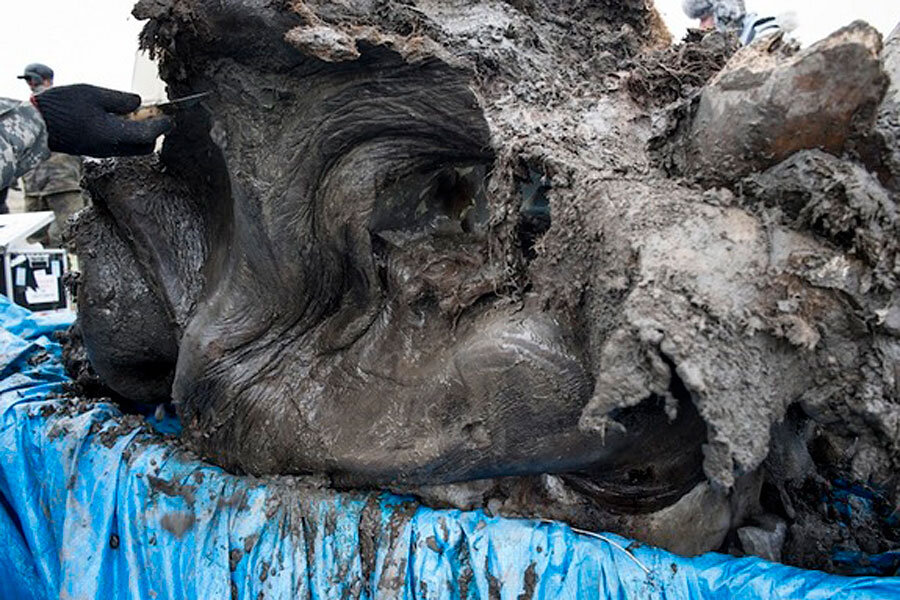Can we clone a woolly mammoth? Should we?
Loading...
A woolly mammoth carcass recently unearthed in Siberia could be the best hope yet for scientists aiming to clone the massive, long-extinct beast.
The mammoth specimen, which was discovered in 2013 in a remote part of Siberia, oozed a deep red liquid when it was first discovered. Scientists have now analyzed the mammoth to understand how it lived and died — and whether it will yield enough undamaged DNA to make cloning the extinct creature a reality.
Details from the mammoth autopsy will air in the Smithsonian Channel special called "How to Clone a Woolly Mammoth," on Nov. 29 at 8 p.m. ET/PT. (Warning: This story contains some spoilers about the Smithsonian Channel special.) [See Images from the Woolly Mammoth Autopsy]
Stunning find
In May 2013, scientists from the Siberian Northeastern Federal University crossed the icy expanse of Siberia to reach Maly Lyakhovsky Island in the far north, where rumor had it a mammoth was lurking in the permafrost. At the time, two giant tusks were poking out of the ground, but when the researchers dug further, they found an almost complete mammoth, with three legs, most of the body, part of the head and the trunk still intact.
During excavations, the carcass oozed a dark red liquid that may have been fresh mammoth blood. In fact, the mammoth meat was reportedly fresh enough that one of the scientists took a bite of it.
"This is definitely one of the best samples people have ever found," Insung Hwang, a cloning scientist at the SOOAM Biotech Research Center, said in the show.
In the past, mammoths have yielded only a few dried specks of blood, and none of them left enough intact DNA for a cloning experiment.
Life and death
The researchers then took the carcass to Yakutsk in Russia, where a group of experts had just three days to thoroughly examine the specimen before it was refrozen to prevent rotting. The team used carbon dating to determine that the female mammoth, nicknamed Buttercup, lived about 40,000 years ago. Tests conducted on the mammoth's teeth revealed it was likely in its mid-50s.
Based on growth rates from the tusks, the team deduced that the mammoth had also successfully weaned eight calves and lost one baby. Feces and bacteria in the intestines revealed the ancient matriarch ate grassland plants such as buttercups and dandelions.
Tooth marks on her bones helped the scientists glean information about Buttercup's grisly end. The mammoth had become trapped in a peat bog and was eaten alive from the back by predators such as wolves.
While scientists probed the elbow of the mammoth, the large beast oozed more blood. Chemical analyses revealed that the blood cells were broken, but still contained hemoglobin, or oxygen-ferrying molecules. Unlike humans and other mammals, mammoths evolved a cold-resistant form of hemoglobin that could survive at the near-freezing temperatures present during the Ice Age.
"The fact that blood has been found is promising for us, because it just tells us how good of a condition the mammoth was kept in for 43,000 years," Hwang said.
Cloning a mammoth?
But whether or not Buttercup can be resurrected is another matter.
DNA is fragile and must be stored at low temperatures and in uniform humidity to stay intact. Past mammoth carcasses have looked exceptionally well-preserved, with some even yielding a preserved mammoth brain. Others have oozed what looked like blood, but ultimately did not have enough DNA to recreate the mammoth genome and clone it.
So far, the team hasn't found a complete copy of the mammoth's genome. But Buttercup's tissue has revealed some very long fragments that could potentially be pieced together to recreate the genome. Still, researchers are continuing to hunt for a complete copy.
Yet, even if a complete sample of undamaged DNA can't be found, there may be other ways to clone a mammoth, said Harvard University researcher George Church. He is hoping to combine DNA from Buttercup with modern-day elephants, essentially grafting the DNA for hair, tusks and other distinctive mammoth features into the genome of the animal's modern-day relatives.
Follow Tia Ghose on Twitter and Google+. Follow Live Science @livescience, Facebook & Google+.Originally published on Live Science.
- Image Gallery: Stunning Mammoth Unearthed
- Skin and Bones: Inside Baby Mammoths
- 6 Extinct Animals That Could Be Brought Back to Life
Copyright 2014 LiveScience, a TechMediaNetwork company. All rights reserved. This material may not be published, broadcast, rewritten or redistributed.







